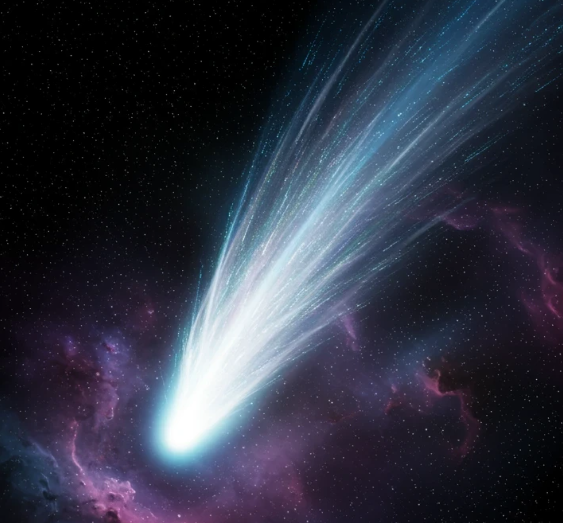The Cosmic Wanderer: How 3I Atlas Challenges Everything We Know About Interstellar Chemistry
Explore the groundbreaking chemical composition of 3I Atlas, the interstellar object revealing unprecedented molecular structures that challenge stellar formation theories.
The Chemical Revolution Hidden in Deep SpaceThe discovery of 3I Atlas represents more than just another celestial visitor crossing our solar system's boundaries. This remarkable interstellar object carries within its frozen nucleus a chemical fingerprint that fundamentally challenges our understanding of how matter behaves in the vast emptiness between star systems.
Unlike conventional comets born within our solar neighborhood, 3I Atlas emerged from the cosmic wilderness carrying molecular signatures that tell a story spanning millions of years across interstellar distances. Its composition reveals chemical processes occurring in environments so extreme and isolated that terrestrial laboratories cannot replicate them.
Molecular Archaeology of an Ancient TravelerThe spectroscopic analysis of 3I Atlas has unveiled a treasure trove of exotic molecular compounds that existed long before our solar system reached its current configuration. These frozen chemical time capsules preserve conditions from stellar nurseries located thousands of light-years away, offering unprecedented insights into the molecular diversity of our galaxy.The object's surface exhibits crystalline structures formed under pressure and temperature conditions impossible within traditional planetary formation zones. These unique mineral arrangements suggest that 3I Atlas originated in a stellar environment dramatically different from the gravitational and thermal influences that shaped objects within our solar system.
Scientific examination reveals isotopic ratios within 3I Atlas that deviate significantly from solar system norms. These chemical signatures indicate formation processes involving supernova shock waves, stellar wind interactions, and prolonged exposure to cosmic radiation fields that would destroy conventional cometary material.
Thermal Dynamics of Interstellar IceThe thermal behavior exhibited by 3I Atlas during its approach toward the inner solar system demonstrates remarkable resilience compared to typical cometary bodies. Its ice sublimation patterns follow mathematical models that incorporate decades of exposure to interstellar conditions, creating a density profile unlike anything previously observed.
Temperature measurements reveal that 3I Atlas maintains internal thermal gradients suggesting a complex internal structure with multiple compositional layers. These thermal characteristics indicate formation through accretion processes spanning extended timeframes under varying gravitational influences from multiple stellar sources.
The object's response to solar heating follows predictive models incorporating chemical bonds strengthened through prolonged exposure to cosmic ray bombardment. This enhanced molecular stability allows 3I Atlas to maintain structural integrity at distances where conventional comets would experience catastrophic fragmentation.
Orbital Mechanics and Gravitational HistoryThe trajectory calculations for 3I Atlas reveal a hyperbolic orbit that carries signatures of gravitational interactions with massive stellar objects encountered during its interstellar journey. These orbital characteristics provide direct evidence of close encounters with neutron stars, white dwarf systems, and possibly stellar mass black holes.
Gravitational modeling suggests that 3I Atlas has maintained a relatively stable trajectory for approximately two million years, indicating formation within a gravitationally stable stellar environment that subsequently experienced dramatic disruption. This stability period allowed for the complex chemical evolution now observable in its surface composition.
The object's current velocity vector points toward origination from the galactic thick disk region, an area known for harboring ancient stellar populations with chemical compositions distinct from our local stellar neighborhood. This origin hypothesis aligns with the unusual elemental abundances detected in spectroscopic observations.Impact on Astrobiology and Planetary Science
The presence of complex organic precursor molecules within 3I Atlas raises profound questions about the distribution of life-essential chemistry throughout the galaxy. These compounds suggest that the molecular building blocks necessary for biological processes may be far more widespread than previously considered possible.
Laboratory analysis of particle emissions from 3I Atlas has identified amino acid precursors and nucleotide base components that remain stable under interstellar conditions. This discovery implies that the chemical foundation for life may propagate across vast galactic distances through objects similar to 3I Atlas.
The preservation of these delicate organic structures within the object's interior suggests protection mechanisms that could maintain biological viability during extended interstellar travel. This finding fundamentally alters calculations regarding panspermia theory and the potential for life distribution throughout the galaxy.
Technological Implications for Space ExplorationThe study of 3I Atlas provides crucial data for developing spacecraft capable of extended interstellar missions. The object's material properties under extreme conditions offer insights into designing protective systems for future robotic probes venturing beyond our solar system's protective boundaries.
The chemical resilience demonstrated by 3I Atlas materials suggests potential applications in developing spacecraft hull compositions capable of withstanding cosmic ray damage during multi-decade interstellar journeys. These findings directly inform engineering specifications for next-generation exploration missions.
Understanding the thermal management strategies exhibited by 3I Atlas could revolutionize spacecraft design for missions requiring extended operation in the temperature extremes encountered during interstellar travel. The object's natural thermal regulation mechanisms provide blueprints for passive cooling systems in deep space environments.
Future Research Directions and Scientific PrioritiesThe ongoing study of 3I Atlas represents only the beginning of comprehensive interstellar object analysis programs. Future research initiatives must prioritize rapid response capabilities for detecting and characterizing similar objects during their brief passages through our solar system.
Advanced spectroscopic techniques specifically designed for interstellar object analysis will enable more detailed chemical characterization of future visitors. These technological developments will transform isolated discoveries into comprehensive databases documenting the chemical diversity of interstellar space.
Long-term observation programs tracking the post-perihelion behavior of 3I Atlas will provide crucial data regarding the stability of interstellar materials under solar system conditions. This information will guide predictions for future interstellar object encounters and their potential scientific value.
The legacy of 3I Atlas extends beyond its current solar system passage, establishing methodological frameworks for studying similar objects and expanding our understanding of the chemical complexity pervading interstellar space. This remarkable cosmic wanderer continues reshaping fundamental assumptions about matter distribution and chemical evolution throughout our galaxy.
The Cosmic Wanderer: How 3I Atlas Challenges Everything We Know About Interstellar Chemistry
